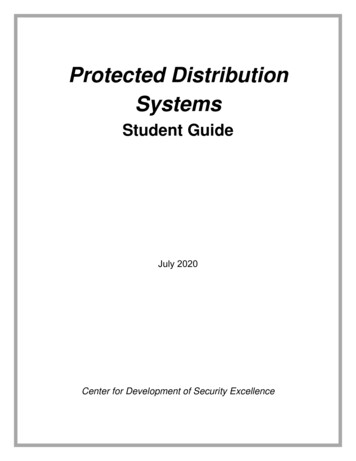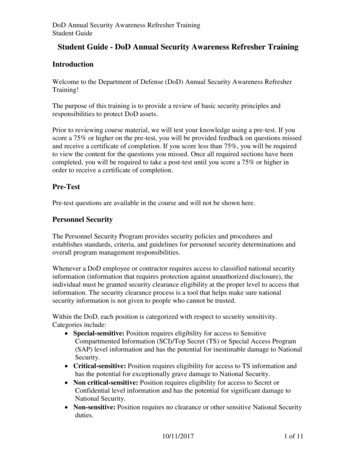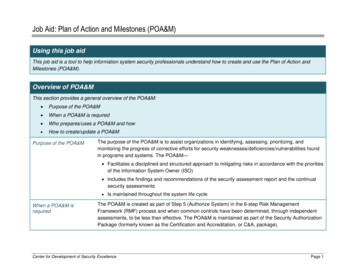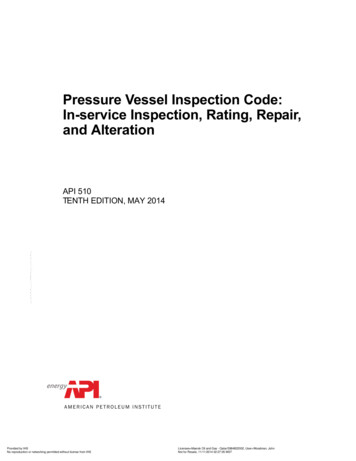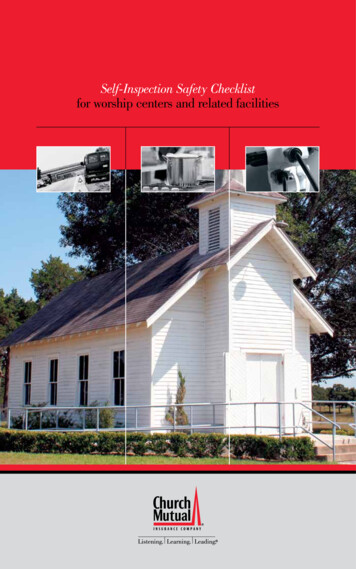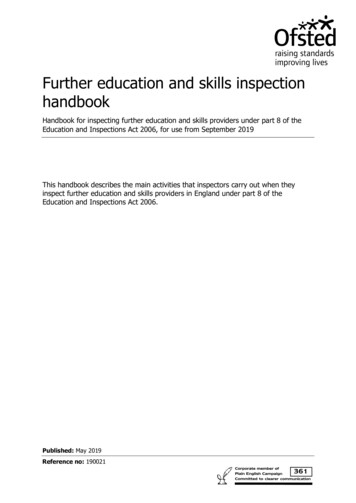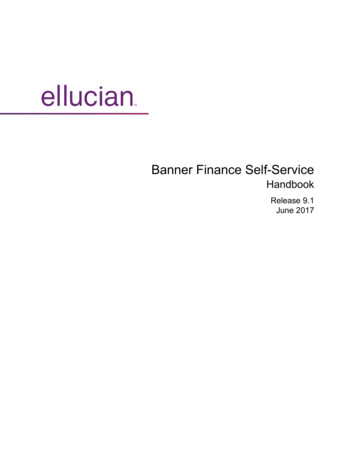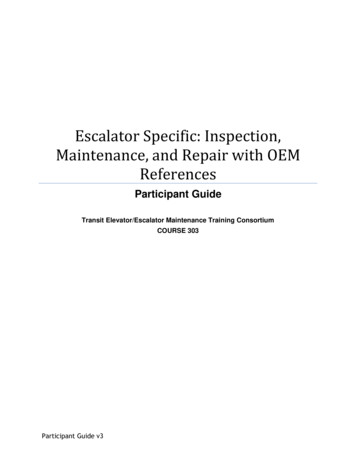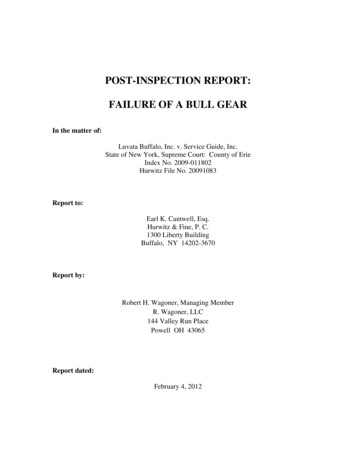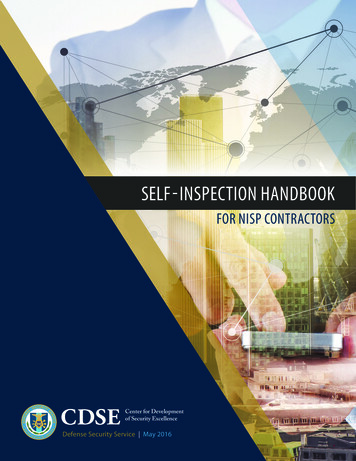
Transcription
Self-inspection handbookfor nisp contractorsCenter for Developmentof Security ExcellenceDefense Security Service May 2016
Self-Inspection Handbook for NISP ContractorsTABLE OF CONTENTSThe Contractor Security Review Requirement . 2The Self-Inspection Handbook for NISP Contractors . 2The Elements of Inspection . 2-3Self-Inspection Process . 3-7Self-Inspection Checklist . 8ELEMENTS OF U.V.W.X.Y.FACILITY CLEARANCE (FCL) . 9-10ACCESS AUTHORIZATIONS . 10-12SECURITY EDUCATION . 12-15CONSULTANTS . 15STANDARD PRACTICE PROCEDURES (SPP) . 16SUBCONTRACTING . 16-17VISIT CONTROL . 18CLASSIFIED MEETINGS . 19-20CLASSIFICATION . 20-21EMPLOYEE IDENTIFICATION . 22FOREIGN OWNERSHIP, CONTROL, OR INFLUENCE (FOCI) . 22-24PUBLIC RELEASE . 24CLASSIFIED STORAGE . 25-27CONTROLLED ACCESS AREAS . 28-30MARKINGS. 30-31TRANSMISSION. 32-34CLASSIFIED MATERIAL CONTROLS. 34-36REPRODUCTION . 36-37DISPOSITION. 38-39INFORMATION SYSTEMS (IS). 39-54COMSEC/ CRYPTO . 54INTERNATIONAL OPERATIONS . 55-60OPERATIONS SECURITY (OPSEC). 60SPECIAL ACCESS PROGRAMS (SAP) . 61INSIDER THREAT PROGRAM 61-67INTERVIEWING EMPLOYEESGeneral Interviewing Techniques . 4Suggested Questions When Interviewing Employees. 5-7May 20161Self-Inspection Handbook for NISP Contractors
SELF-INSPECTION HANDBOOK FOR NISP CONTRACTORSThe Contractor Security Review Requirement“Contractors shall review their security system on a continuing basis and shall also conduct aformal self-inspection, including the self-inspection required by paragraph 8-101h of chapter 8 ofthis Manual, at intervals consistent with risk management principles.” “These self-inspectionswill be related to the activity, information, information systems (ISs), and conditions of the overallsecurity program, to include the Insider Threat program; have sufficient scope, depth, andfrequency; and management support in execution and remedy.” [1-207b, 1-207b(1) NISPOM]The Self-Inspection Handbook for NISP ContractorsThe National Industrial Security Program Operating Manual (NISPOM) requires all participantsin the National Industrial Security Program (NISP) to conduct their own self-inspections toinclude an insider threat self-assessment. This Self-Inspection Handbook is designed as a jobaid to assist you in complying with these requirements. It is not intended to be used as achecklist only; rather, it is intended to assist you in developing a viable self-inspection programspecifically tailored to the classified needs of your cleared company. You will also find we haveincluded various techniques that will help enhance the overall quality of your self-inspection.Purpose of a Self-InspectionSelf-inspections provide insight into your security program. It provides you an opportunity tolook at the security procedures established at your company and validate that they not onlymeet NISPOM requirements but they are being effectively implemented by your clearedemployees.This is your chance to take an honest look at what your company is doing to protect ournational security: to see what is working, what is working well and what you may need tochange. Remember you should not be conducting your self-inspection just because theNISPOM requires you to. You should be conducting your self-inspection to ensure thecontinued protection of our national security, our country, its citizens, and most importantly ourmilitary service men and women.The Elements of InspectionThe Self-Inspection Checklist contained within this handbook addresses basic NISPOMrequirements through a series of questions arranged according to “Elements of Inspection.” Itis important to know that not all “Elements of Inspection” will apply to every cleared company.Before beginning your self-inspection, it is recommended that you review the “Elements ofInspection” to determine which ones are applicable to your facility’s involvement in the NISP.Then use those elements to customize a self-inspection checklist unique to your securityprogram.There are seven “Elements of Inspection” that are common to ALL cleared companiesparticipating in the NISP and should be incorporated into your customized self-inspection checklist: (A)May 20162Self-Inspection Handbook for NISP Contractors
Facility Security Clearance (FCL), (B) Access Authorizations, (C) Security Education, (G)Classified Visits, (I) Classification, (K) FOCI, and (Y) Insider Threat. Any remaining elementsneed to only be covered if they relate to your security program. If you have questions about therelevancy of any element of inspection for your facility, please contact your Industrial SecurityRepresentative (IS Rep) for guidance. A look at your Standard Practice Procedure (SPP), ifyou have one, may also provide clues. Of course, as your program becomes more involvedwith classified information (e.g., changing from a non-possessing to a possessing facility), youwill have to expand your self-inspection checklist to include those additional elements ofinspection.Also remember that not all of the questions (requirements) within each element may relate toyour program. Since each question includes a NISPOM paragraph citation, review eachrequirement against the context of your industrial security program. If your involvement withclassified information invokes the requirement, your procedures should comply with it and yourself-inspection should assess your compliance. Reading all questions in the relevant elementsof inspection will help you become more knowledgeable of the NISPOM requirements. In allcases, the regulatory guidance takes priority over company established procedures.Self-Inspection ProcessTo be most effective, it is suggested that you view your self-inspection as a three-step processrather than an event: 1) pre-inspection, 2) self-inspection, and 3) post-inspection.1) PRE-INSPECTION.So that you are fully prepared for your self-inspection, you want to start by conducting your preinspection research: 1) identify all security elements that apply, 2) familiarize yourself with howyour company’s business is structured and organized (it may have an impact on yourcompany’s security procedures), 3) identify who you will need to talk to and what records youmay want to review, 4) prepare a list of questions and topics that need to be covered, 5) knowyour facility’s physical layout (i.e., where the classified material is stored, worked on, etc.), 6)identify the current threats to your company’s technologies, and 7) have a basic knowledge ofyour company’s classified programs.Remember, your primary sources of information during your self-inspection are yourdocuments and people. Take the time to adequately prepare yourself by reviewingdocumentation you already have on-hand. This includes the results of your last DSS securityvulnerability assessment, your current DD Form 254s and classification guides, any recentcompany press releases or publications, your company web-site, any security records you mayhave on hand, and the JPAS records for your cleared employees.Once you have completed your pre-inspection research, your next step is to set the date toconduct your self-inspection. Once your date is established, meet with your seniormanagement team so they can understand the importance of your self-inspection and providethe support you need to be effective. Also take the time to meet with program and departmentmanagers to let them know what support you might need from them during the self-inspectionprocess. Finally, make a formal announcement so that your employees will know what toexpect.May 20163Self-Inspection Handbook for NISP Contractors
2) SELF-INSPECTION.The self-inspection process includes gathering information about each of the inspectionelements that apply to your company’s classified involvement. Your job as the FSO is to verifyand validate that your facility security program is in compliance with applicable NISPOMrequirements and that all classified information entrusted to your company is adequatelyprotected. To do this, simply review the self-inspection questions against the appropriatedocumentation (including your classified information) and the people (including their actions)involved in the facility’s industrial security program. This is where the self-inspection checklistcomes in handy. It not only provides you with the NISPOM requirements, but organizes theminto elements of common security concern. These elements should not be viewedindependently during your self-inspection, but interdependently, as it will become obvious to youthat they frequently interrelate.During the self-inspection, you want to ensure that you take the time to explain the selfinspection process and what is to be expected to each employee you interview. This may betheir first time going through any type of inspection; people tend to be reluctant to provideinformation when they don’t know why they are providing it. Don’t limit yourself to just talkingwith your employees. Look at their processes, have them demonstrate what they do whenworking with classified information, spot check documentation, and inspect security equipmentto include any Intrusion Detection Systems (IDS), Information Systems (IS), and securitycontainers that they have access to or are responsible for.A quality self-inspection depends on your ability to ask questions and listen to the answers youreceive. They may identify security problems you would otherwise not be brought to yourattention. Seek information about current procedures and changes, which could affect futureactions. Get out of your office and into the working environment. Check security records, testsecurity systems, and most importantly talk to people!There are certain titled employees you may want to target for interviews during your selfinspection to include your key management personnel, both your cleared and unclearedemployees, the webmaster, program managers, human resources personnel, contractspersonnel, the receptionist, and mailroom personnel to name a few.Here are some general interviewing techniques and questions to assist you in conductingquality interviews during your self-inspection:General Interviewing Techniqueso All questions should be asked in the present and future sense.o Talk in a conversational tone and maintain eye contact.o Let people tell their story. Ask open ended questions (using who, what, where, when, why,and how).o Avoid leading questions.o Let people show you how they perform their jobs that involve compliance with a securityprogram requirement.o Follow-up the checklist questions with your own questions.o Keep good notes for future reference and document corrective actions.May 20164Self-Inspection Handbook for NISP Contractors
Suggested Questions When Interviewing Uncleared Employees:oWhat is classified information?oHow would you know if something was classified?oIf you found unprotected, classified information, what would you do?oHave you ever heard classified information being discussed?oHave you ever come into possession of classified materials? How?Suggested Questions When Interviewing Cleared Employees:oWhat is your job title/responsibility?oWhat is the level of your security clearance?oWhy are you cleared (describe the contract or programs that require you to be cleared)?oHow long have you been cleared?oIf recently cleared, what were the processes/steps in applying for your security clearance?oWhen was your last access to classified information and at what level?oHave you ever accessed classified information outside of this facility?oWhat are the procedures for individuals going on classified visits?oHow about visitors coming here for a classified visit?oDid anyone else from the facility accompany you on this visit?oWhat procedures did you follow prior to your classified visit?oDid you take any classified notes or bring any classified information back to the facility?oWhat procedures were followed to protect this information?oWhere is this information now?oHave you ever allowed visitors to have access to classified information?oHow did you determine their need-to-know?oHave you ever been approached by anyone requesting classified information?oDo you ever work overtime and access classified information?oWhen was the last time that you had a security briefing?May 20165Self-Inspection Handbook for NISP Contractors
oWhat can you recall from this briefing?oCan you recall any of the following being addressed in briefings?nnnnRisk ManagementPublic ReleaseAdverse InformationCybersecuritynnnnJob Specific Security BriefSafeguarding ResponsibilitiesCounterintelligence AwarenessInsider ThreatoWhat is meant by the term adverse information and how would you report it?oCan you recall any other reportable items?oWhat is an insider threat?oWhat are some indicators of insider threat behavior and who would you report this to?oCan you recall any methods used to recruit trusted insiders?oWhat is meant by the term suspicious contact and how would you report one?oHave you ever been cited for a security violation, infraction, or incident?oWhat would you do if you committed a security violation, infraction, or discovered one?oDo you have the combination to any storage containers, access to any Closed Areas, etc.?oWhat are the security requirements regarding combinations to security containers?oWho, other than yourself, has access to these containers?oHow do you keep track or maintain your knowledge of the combination?oIs a record maintained of the safe combination? If so, where?oDo you generate or derivatively classify information? Tell me about it.oWhat security controls are established?oHow do you know it’s classified?oDescribe the training you received prior to derivatively classifying or generating classified.oWhere do you typically work on classified information?oWhat procedures do you follow to protect classified information while working on it?oWhat do you do with classified information?oDo you ever use a computer to generate classified information?oHow do you mark this information?May 20166Self-Inspection Handbook for NISP Contractors
oWhat information or references do you use when classifying information?oPlease produce the classification guidance that you used. Is it accurate?oWhat would you do if you determined that the classification guidance was not accurate?oWhat are the security procedures for publishing classified papers, etc.?oDo you ever handcarry any classified information outside of your company?oWhat procedures do you employ when handcarrying classified material?oHave you ever reproduced classified information? Describe the procedures.oHave you ever destroyed classified information? What procedures were used?oDo you have any questions regarding security?NOTE: In addition to asking questions, it is a good idea to ask cleared employees todemonstrate how they perform their security-related tasks, e.g., “Show me what you dobefore processing classified information on your computer” or “Show me how youprepare a package for shipment.” This will allow you not only to verify what the correctprocedures are, but to ensure those procedures are being carried out and that classifiedinformation is being protected.3) POST- INSPECTION.Once you have completed your self-inspection, you are not yet done. In fact, your real work hasjust begun. Make sure you take whatever action is necessary to correct any problem areas youidentified during your self-inspection. You may even have to develop additional securityeducation materials to address these problem areas.It is important to provide immediate feedback to both your management and employees. Afterall, you spent a lot of time to get them vested in this process. Make sure to keep them vestedby providing good, honest feedback. Remember the information you gathered during your selfinspection can only help to improve the overall effectiveness of your security program. Makesure to highlight any successes as well as any problem areas requiring corrective action foundduring your self-inspection. It is always a good idea to make an effort to provide “kudos” to anyof your employees that were found to go above and beyond your established securityprocedures to ensure the protection of your classified material.Finally, you must prepare a formal report describing the self-inspection, its findings, andresolution of issues found and retain this formal report for DSS review through the next DSSsecurity vulnerability assessment. Additionally a senior management official at your facility willcertify to the CSA (DSS), in writing on an annual basis that a self-inspection has beenconducted, that senior management has been briefed on the results, that appropriatecorrective action has been taken, and that management fully supports the company’s securityprogram.May 20167Self-Inspection Handbook for NISP Contractors
SELF-INSPECTION CHECKLISTAs you work through the Self-Inspection Checklist, answer each question that applies to yoursecurity program. For those that do not apply, simply annotate N/A. We also recommend thatfor each question that applies to your security program, you utilize the space titled Validation todocument the actions taken to validate the answer provided.You will also notice that we have provided links to various resources available in our FSOToolkit to assist you in verifying the effectiveness of your security program. Feel free to take alook at these resources to assist you in conducting the most thorough self-inspection possible.You are now ready to conduct the best self-inspection ever – good luck!May 20168Self-Inspection Handbook for NISP Contractors
The Self-Inspection ChecklistA. FACILITY CLEARANCE (FCL)NISPOMREF:1-302g(3)Question:YESNON/AHave all changes (e.g. changes in ownership, operating name oraddress, Key Management Personnel (KMP) information, previouslyreported FOCI information, or action to terminate business) affecting thecondition of the FCL been reported to your DSS IS Rep, to includerequired information?VALIDATION:2-100cHas the company’s FCL been used for advertising or promotionalpurpose?VALIDATION:2-104Are the senior management official, the Insider Threat Program SeniorOfficial (ITPSO), the FSO, an
company’s security procedures), 3) identify who you will need to talk to and what records you may want to review, 4) prepare a list of questions and topics that need to be covered. 5, ) know your facility’s physical layout (i.e., wher
